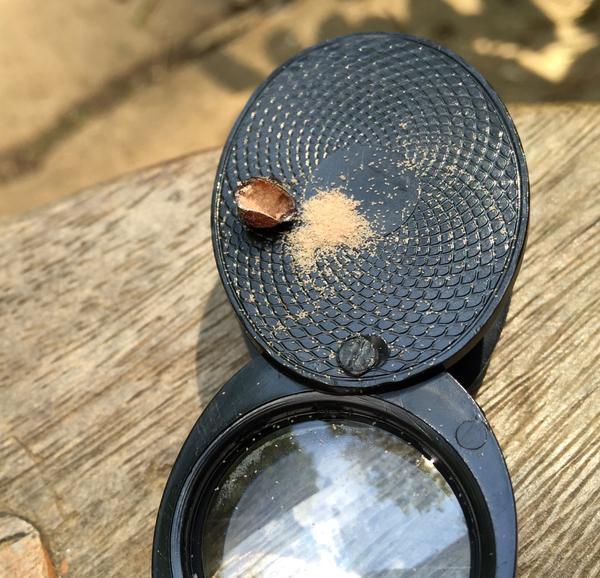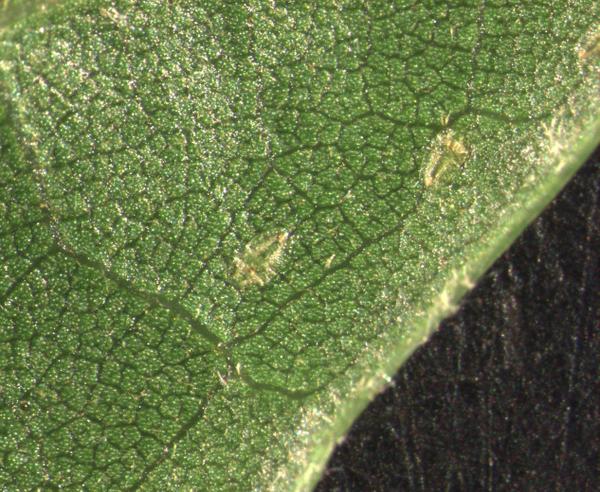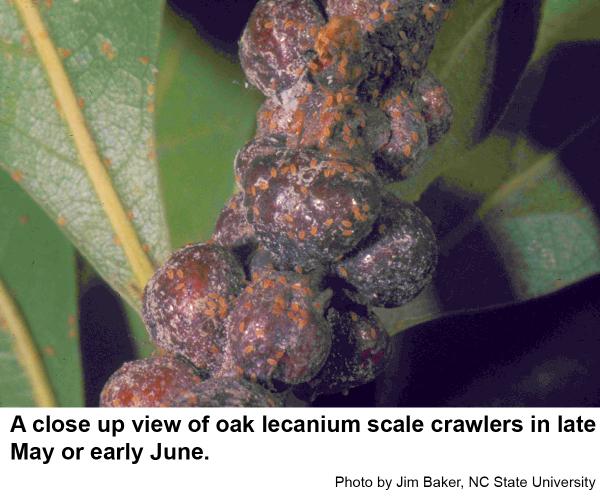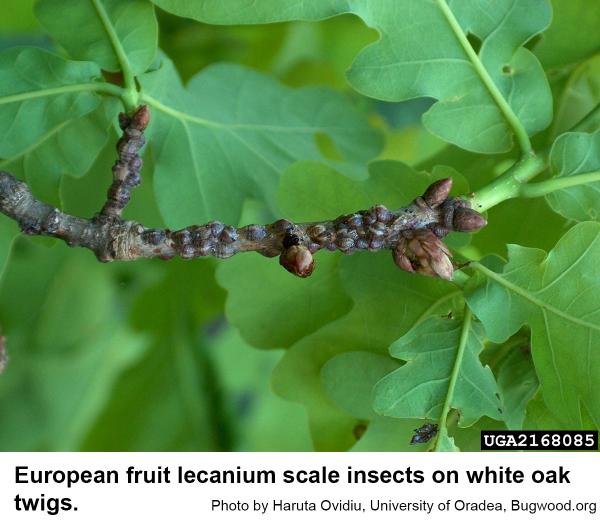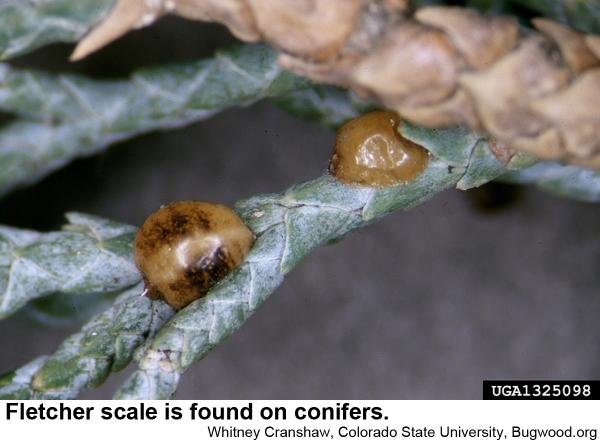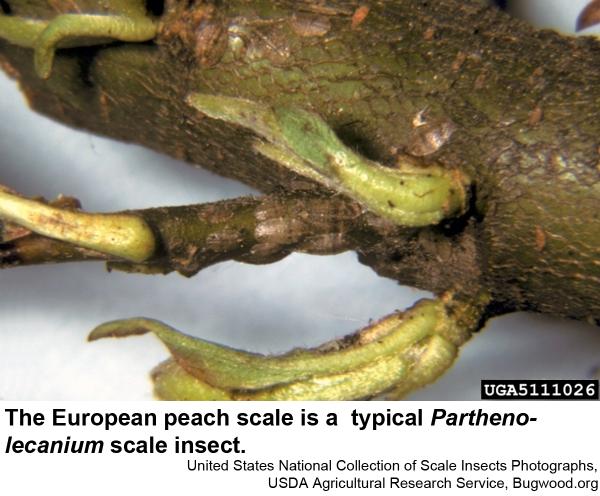General Information
Some scale insects in the genus Parthenolecanium are commonly called lecanium scales because at one time they were included in the genus Lecanium. Female oak lecanium scales, Parthenolecanium quercifex, are up to 1/4 inch in diameter. When fully grown, female scales are rounded to hemispherical and reddish to dark brown. The very similar European fruit lecanium scale, Parthenolecanium corni, also infests many of the same plants and may even occur mixed with oak lecanium scales. The European peach scale, Parthenolecanium persicae and the Fletcher scale, Parthenolecanium fletcheri, also infest trees and shrubs in North Carolina. The life history of these scales is similar. Male scales are tiny, flying, brown insects that have a long "tail" called the style, and they have two white strands that trail from the body. You are unlikely to see males. Eggs are almost white and resemble fine pollen. Lecanium scales lay 1,000 to 5,000 eggs each in April and May. As the eggs are laid, the body of the scale shrinks against the outer skin to form a helmet-like protective shield. Flat, pale crawlers soon hatch and move to the leaves in late May and early June where they feed until late summer. Crawlers have legs and antennae but are very small and translucent. Crawlers molt into a second stage that moves back to the twigs to spend the winter. These nymphs hibernate under a thin, waxy shield. Older nymphs are flat and brown. The legs and antennae become less noticeable as nymphs mature. Males develop into a pupal stage that is a pale peach color and is covered by a translucent waxy coat. Males usually pupate and emerge in early spring although some lecanium scales can lay fertile eggs without mating. As adult females mature, they become rounded and hardened. These lecanium scales suck sap from the leaves and twigs of shade trees and other woody ornamental plants, and they excrete honeydew, a sweet, sticky liquid in which sooty mold fungi may eventually grow. Lecanium scales often become abundant in landscapes that participate in mosquito abatement programs or near areas treated with insecticides for other pests. Such spraying eliminates predators and parasites that usually keep lecanium scale populations unnoticably low.
Host Plants
Oak lecanium scale insects are most often associated with oaks, but hickory, birch and many other trees and shrubs are also attacked. European fruit lecanium infest many of the same hosts and fruit trees. Infested trees often become sticky with honeydew excreted by these scales. Honeydew in turn fosters sooty mold fungi that darken the leaves, stems and objects below the infested plant. Bees, wasps, flies, and ants are often attracted by honeydew on and under infested trees. Heavy scale infestations frequently build up on the lower leaf surface, and such feeding damage may cause curled, chlorotic (yellow) foliage that may drop prematurely. Smaller infested branches are sometimes weakened or even killed. The European peach scale tends to be a pest of grape vines, and Fletcher scales usually infest hemlock and other conifers.
Recommendations
Oak lecanium and European fruit lecanium become very abundant on urban trees due to high temperatures and drought created by impervious soil surface coverings. Thus, when planting trees provide them with adequate space and water. Because of the shelter of the dead mother scale, lecanium scale eggs are protected from pesticides. However, in May the eggs hatch and by late June the crawlers are out from under the dead mothers and are exposed and more susceptible to pesticides. Any of the insecticides labeled for landscape use should give more than adequate control of crawlers including horticultural oils, which help preserve the natural enemies that feed on scales. Horticultural oils also reduce spider mite abundance. Applications of contact insecticides like pyrethroids are frequently linked to scale insect outbreaks.
To control scales on large trees, a systemic insecticide can be applied to or injected into the soil or trunk. See the Southeastern US Pest Control Guide for Nursery Crops and Landscape Plantings for more information on insecticide options for soft scales.
Other Resources
- Life History and Natural Enemies of Parthenolecanium spp. in Four Southeastern States. Camacho, E. R. 2015. Clemson University, TigerPrints, All Dissertations, Dissertations.
- European Fruit Lecanium, Parthenolecanium corni (Bouché). Gregory A. Hoover, Sr., G. A. 2006. Department of Entomology, College of Agricultural Sciences, PennState.
- Scale Insects. Day, E. 2015. Virginia Cooperative Extension, Virginia Tech, Virginia State University. 2808 1012_pdf.
- Agronomic Services — Soil Testing. Hudak-Wise, C. M. 2018. North Carolina Department of Agriculture & Consumer Services. Agronomic Services Division.
- Urban Warming Drives Insect Pest Abundance on Street Trees. Meinkeke, E. K., R. R. Dunn, J. O. Sexton, S. D. Frank. 2013. PLOS ONE Vol. 8 (3): e59687.
- Search for more information on insects from NC State Extension
- Insect and Related Pests of Shrubs
- Extension Plant Pathology Publications and Factsheets
- Horticultural Science Publications
Publication date: Feb. 21, 2015
Reviewed/Revised: Oct. 1, 2019
Recommendations for the use of agricultural chemicals are included in this publication as a convenience to the reader. The use of brand names and any mention or listing of commercial products or services in this publication does not imply endorsement by NC State University or N.C. A&T State University nor discrimination against similar products or services not mentioned. Individuals who use agricultural chemicals are responsible for ensuring that the intended use complies with current regulations and conforms to the product label. Be sure to obtain current information about usage regulations and examine a current product label before applying any chemical. For assistance, contact your local N.C. Cooperative Extension county center.
N.C. Cooperative Extension prohibits discrimination and harassment regardless of age, color, disability, family and marital status, gender identity, national origin, political beliefs, race, religion, sex (including pregnancy), sexual orientation and veteran status.

